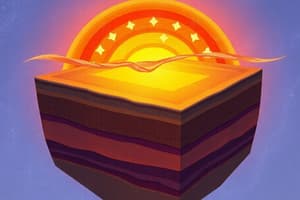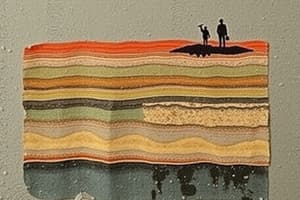Podcast
Questions and Answers
What is the process called when a small ball of candy is rolled in liquid sugar and left to dry, creating a thin layer of candy that sticks to the ball and makes it grow bigger?
What is the process called when a small ball of candy is rolled in liquid sugar and left to dry, creating a thin layer of candy that sticks to the ball and makes it grow bigger?
The process is called layering or coating.
What is the term used in geology to describe the method scientists use for determining the order of events without using actual ages?
What is the term used in geology to describe the method scientists use for determining the order of events without using actual ages?
The term used in geology is relative dating.
What do the layers of rock beneath our feet represent?
What do the layers of rock beneath our feet represent?
The layers of rock represent a record of time passing, with each layer corresponding to a different point in history.
What is relative dating and how does it help determine the age of rock layers?
What is relative dating and how does it help determine the age of rock layers?
What are intrusions and how do they disrupt rock layers?
What are intrusions and how do they disrupt rock layers?
How do faults contribute to the disruption of rock layers?
How do faults contribute to the disruption of rock layers?
What is a fault and how does it affect the layers in the picture?
What is a fault and how does it affect the layers in the picture?
How are faults similar to cracks in a sidewalk?
How are faults similar to cracks in a sidewalk?
What is the significance of the intrusion in the diagram?
What is the significance of the intrusion in the diagram?
What does the position of the intrusion in relation to the fault tell us?
What does the position of the intrusion in relation to the fault tell us?
Flashcards are hidden until you start studying




